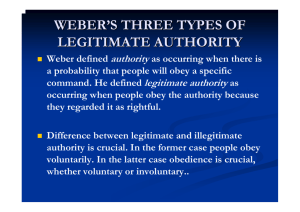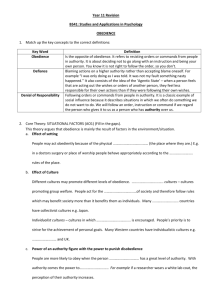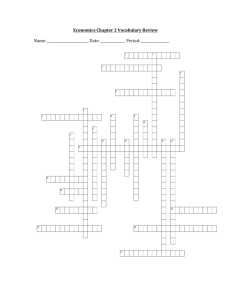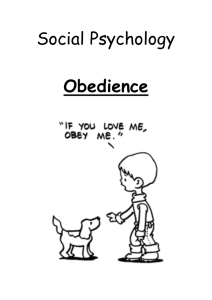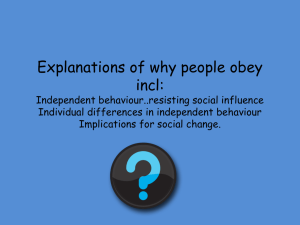blog 9th feb dispositional
advertisement
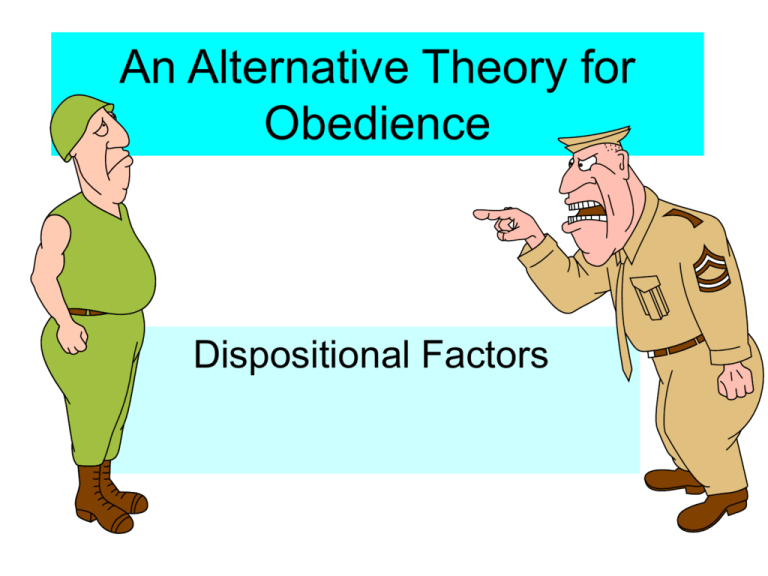
An Alternative Theory for Obedience Dispositional Factors An Alternative Theory for Obedience BATs • Evaluate the Situational theory of Obedience – C+ • Outline the Dispositional Theory of Obedience – D+ • Compare the 2 theories – B+ Situational factors affecting obedience levels SETTING Match the situation to its definition People obey more if the individual giving orders has greater authority. CULTURE People are more likely to obey (or be defiant) if other people in the group are showing that behaviour. AUTHORITY People obey more if the consequences of not obeying are more severe. PUNISHMENT People are more likely to obey in a formal setting such as a library, church or hospital. CONSENSUS Collectivist cultures tend to be more obedient than individualisitic cultures. Situational factors affecting obedience levels SETTING CULTURE AUTHORITY Match the situation to its definition People obey more if the individual giving orders has greater authority. People are more likely to obey (or be defiant) if other people in the group are showing that behaviour. People obey more if the consequences of not obeying are more severe. PUNISHMENT People are more likely to obey in a formal setting such as a library, church or hospital. CONSENSUS Collectivist cultures tend to be more obedient than individualisitic cultures. Criticisms (limitations) of the Situational Theory of Obedience • Read p 54 ‘Criticisms of the Situational Factors Explanation of Obedience’ • Copy the headings and write an explanation in your own words • Find out what demand characteristics are and add it to the glossary Evaluation: Is obedience really affected by situational factors? • A lot of evidence comes from experimentation so may have little to do with obedience in real-life. • This approach assumes that all people are as obedient as each other – it just depends on the situation. • There is evidence that some people are simply more obedient than others regardless of the situation. These people are sometimes described as having an authoritarian personality. An Alternative Theory Dispositional Factors The situation is irrelevant The disposition (personality) of the person is more important The Authoritarian Personality • Read p 54-55 – ‘An Alternative Theory’ • Answer the following questions .. 1. Who claimed there was an Authoritarian Personality? When? 2. What originally drove him and his colleagues to do this research? 3. What type of research did they use (procedure)? 4. What does the F-scale mean? 5. What did Adorno think was the reason people had an Authoritarian personality? A quick investigation… • • Look at Activity 4.7 p55 On the scrap of paper jot down the following .. 1. Rate how obedient you think you are on a scale from 1-10 (10 = most obedient) 2. Rate how strict you think your parents/carers are on a scale from 1-10 (10 = most strict) • For confidentiality– do not put your name on it, fold up the paper and pass to SJ A quick investigation… • Look at Activity 4.7 p55 Use the data on the board to draw a scatter graph to see if there is a correlation between obedience levels and strictness of upbringing Strictness of upbringing Obedience rating Get Creative … • Using the characteristics of a typical Authoritarian Personality that Adorno came up with in 1950 • Create a Profile of an Authoritarian Personality • How will your person behave? • What sort of job might they have? • What might they believe? Get ideas from TV characters, celebrities and famous people from the past Plenary • Share creations Extension – What are the differences between dispositional and situational factors in obedience? Homework • Choose a celebrity or TV character and explain why you believe they have an Authoritarian personality • Refer to Adorno’s characteristics. • Can this be backed up with a strict upbringing? In next week please


